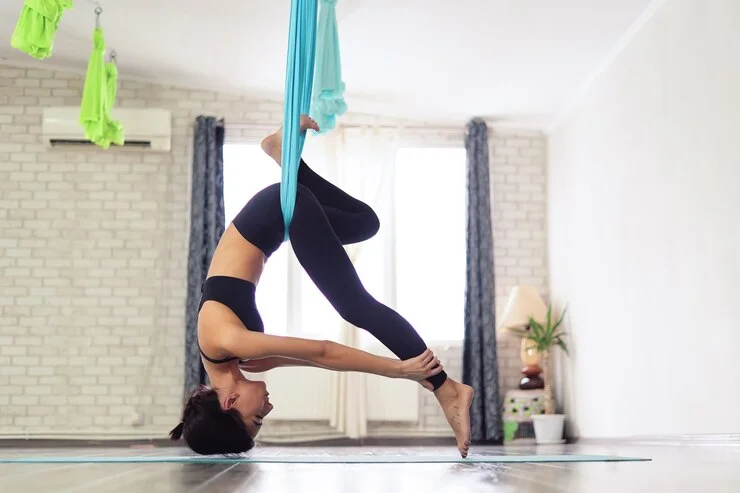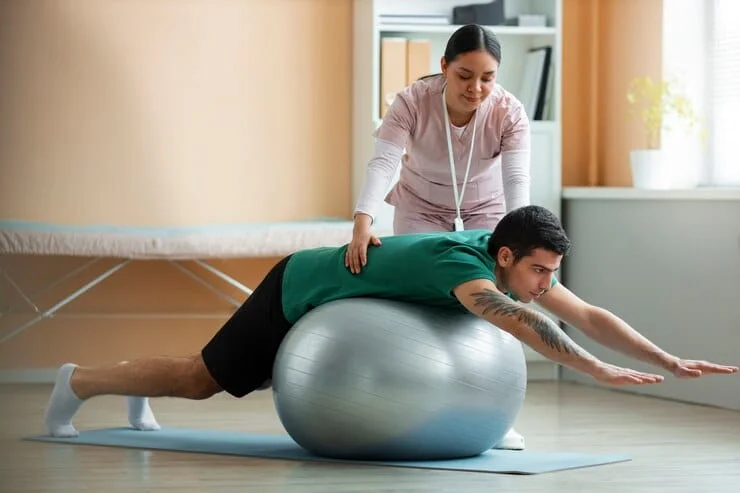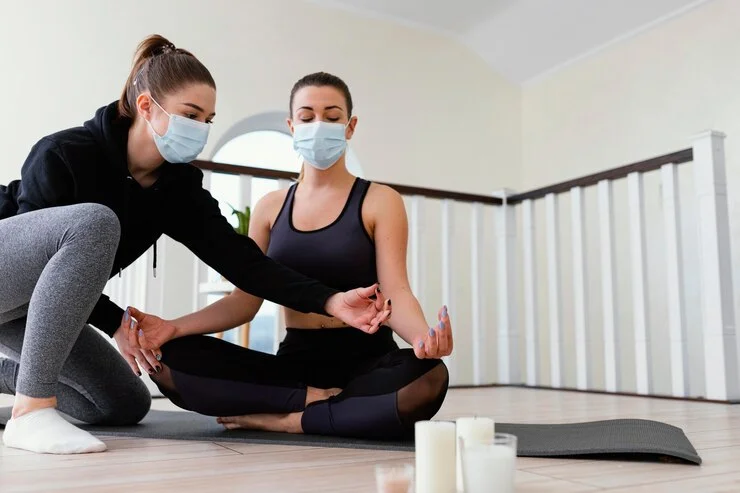Yoga Trapeze: A Complete Guide for Beginners and Beyond
Introduction to Yoga Trapeze
Yoga Trapeze, a modern twist on traditional yoga practices, integrates the use of a suspended hammock to enhance flexibility, strength, and inversion therapy. This innovative approach to yoga has gained significant traction over the last decade, thanks to its unique blend of aerial arts and yoga principles. Originating from the circus arts and later adapted into yoga studios worldwide, Yoga Trapeze offers a playful yet profound way to deepen your yoga practice.
At its core, Yoga Trapeze is about exploring and expanding the body’s capabilities. It allows practitioners to experience yoga poses in a new dimension, using gravity to deepen stretches, relieve back pain, and strengthen the core. Unlike traditional yoga, which is performed on a mat, Yoga Trapeze sessions involve a series of aerial movements and stretches that are both challenging and exhilarating.
The appeal of Yoga Trapeze lies in its versatility. It caters to a wide range of individuals, from beginners seeking to improve their flexibility and balance, to advanced yogis aiming to push their limits with aerial acrobatics. Regardless of your level, Yoga Trapeze offers a unique opportunity to explore the limits of your body and mind in a safe and supportive environment.

Benefits of Yoga Trapeze
The benefits of Yoga Trapeze extend far beyond the novelty of hanging upside down. Practitioners can enjoy a multitude of physical, mental, and emotional advantages that contribute to a well-rounded fitness and wellness routine.
Physical Benefits:
- Improved Flexibility: Regular practice helps stretch and lengthen the spine, significantly improving overall flexibility.
- Enhanced Strength: Yoga Trapeze naturally incorporates bodyweight exercises that strengthen the core, arms, and legs.
- Back Pain Relief: Inversions allow for spinal decompression, offering relief from chronic back pain and improving spinal health.
- Improved Balance and Posture: Working against gravity enhances proprioception, helping to improve balance and posture over time.
Mental Benefits:
- Stress Reduction: The meditative aspects of yoga, combined with aerial movements, can significantly reduce stress levels and promote mental clarity.
- Increased Focus: Navigating through aerial poses requires concentration and focus, enhancing cognitive functions and mindfulness.
Emotional Benefits:
- Boosted Mood: Yoga Trapeze can release endorphins, improving mood and combating feelings of depression or anxiety.
- Increased Confidence: Mastering new poses and overcoming fears of inversion can lead to a significant boost in self-esteem and body confidence.
Incorporating Yoga Trapeze into your fitness routine can offer a refreshing break from the monotony of traditional workouts, providing a fun and challenging way to achieve your health and wellness goals.
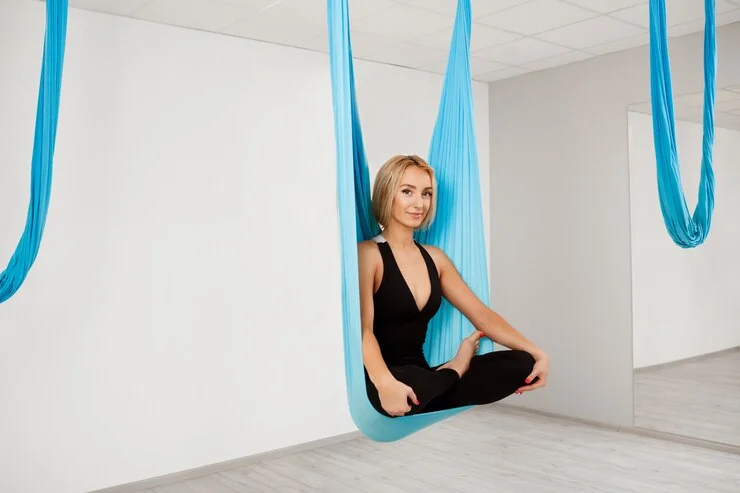
Getting Started with Yoga Trapeze
Preparing for your Yoga Trapeze journey is essential for a safe and enjoyable practice. Here are the key steps to get started:
Equipment Needed: The primary equipment is the Yoga Trapeze itself, which can be purchased online or from specialized fitness stores. Look for a trapeze made from high-quality, durable materials, capable of supporting your weight. The package typically includes the trapeze, carabiners, and support ropes.
Setting Up Your Space: Choose a sturdy support to hang your trapeze, such as a beam, tree branch, or a professionally installed ceiling mount. Ensure the area around your trapeze is clear of obstacles to prevent injuries. The trapeze should hang at about hip height, but you can adjust it based on the exercises you plan to do.
Safety Tips: Always check the equipment for signs of wear and tear before use. Begin your practice on a soft surface like a yoga mat or carpet to cushion any falls. It’s also recommended to have a spotter or instructor guide you through your initial sessions, especially for more complex poses.

Basic Yoga Trapeze Poses for Beginners
Starting with simple poses can help beginners gain confidence and build a foundation for more advanced practices. Here are five basic Yoga Trapeze poses that are perfect for beginners:
Inverted Hang: This is the simplest inversion and a great way to experience the benefits of spinal decompression. Securely hold the handles, lean back, and allow your body to hang freely from the hips. This pose helps to relieve back pain and stretches the spine.
Plank: A fantastic core-strengthening exercise, the plank pose in a Yoga Trapeze adds an extra challenge due to the instability of the swing. Start by gripping the handles, extend your legs behind you, and align your body in a straight line, similar to a traditional plank but suspended.
Flying Pigeon: An excellent pose for opening the hips and improving balance. Begin by placing one foot in the trapeze while keeping the other on the ground. Slowly lift your grounded foot off the floor, extending it behind you as you lean forward, creating a pigeon pose in mid-air.
Aerial Lunges: Great for building leg strength and improving flexibility. Stand facing away from the trapeze and place one foot in the swing behind you. Bend your standing knee to lower into a lunge, keeping your torso upright. The trapeze adds a balance challenge, enhancing the pose’s benefits.
Savasana (Aerial Relaxation): Conclude your practice with a moment of relaxation, floating in the trapeze. Lie back into the swing, letting it support your entire body. Close your eyes and focus on deep breathing, allowing your body to fully relax and absorb the practice’s benefits.
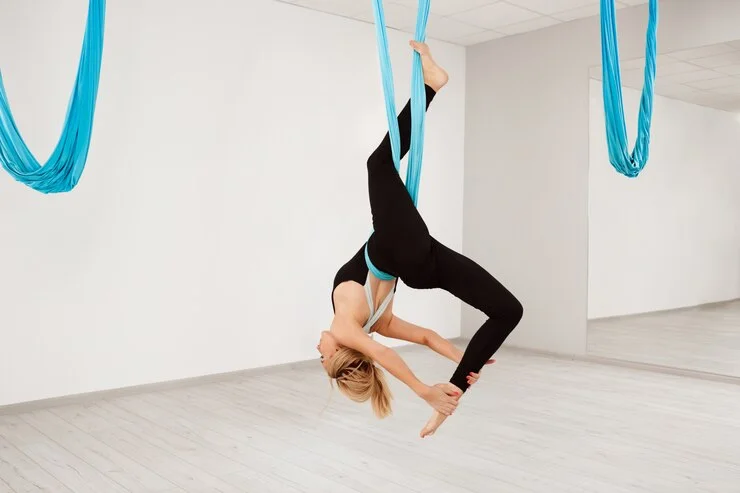
Advanced Yoga Trapeze Poses
As your confidence and skill level increase, you can begin to explore more advanced Yoga Trapeze poses. These poses often involve deeper inversions and require greater strength, flexibility, and balance. Here are a few advanced poses to aspire to:
Aerial Split: This poses challenges to your balance and flexibility. Start by holding the handles and lifting one leg to place it in the trapeze. Gradually split your legs, extending the suspended leg forward and the other backward, balancing with your hands on the handles.
Backbend/Heart Opener: Begin by sitting on the trapeze, then lean back, extending your arms and legs, and open your chest towards the ceiling. This pose stretches the front body and strengthens the back, improving spinal flexibility and posture.
Handstand in the Trapeze: For those ready for an inversion challenge, practicing a handstand with the support of the trapeze can be a thrilling milestone. Start by placing your hands on the ground in front of the trapeze, then kick your legs up, using the trapeze for support as you find your balance.
Aerial Warrior III: A dynamic balance pose, Warrior III in the trapeze adds an element of suspension to the traditional yoga pose. Place one foot in the trapeze, extend your body forward, and lift the trapeze leg back and up, reaching your arms forward for balance.
Incorporating Yoga Trapeze into Your Routine
Incorporating Yoga Trapeze into your routine can add variety and challenge to your practice. Start with short sessions, gradually increasing the duration as you become more comfortable with the poses. A typical session might last between 30 to 60 minutes, depending on your fitness level and goals.
Frequency is key to reaping the benefits of Yoga Trapeze. Aim for 2-3 sessions per week, allowing rest days in between for recovery. As you progress, you can mix Yoga Trapeze with traditional mat yoga or other fitness routines to create a balanced workout schedule.
Remember, consistency and patience are crucial. Yoga Trapeze is a practice that evolves with you, offering endless opportunities for growth and exploration.
FAQs About Yoga Trapeze
Q: Do I need any prior yoga experience to start Yoga Trapeze?
A: No, beginners can start with Yoga Trapeze without previous yoga experience. However, familiarity with basic yoga principles can be helpful.
Q: Is Yoga Trapeze safe for everyone?
A: While Yoga Trapeze is generally safe, those with certain health conditions (e.g., high blood pressure, glaucoma) should consult a doctor first. Always prioritize safety and start with beginner poses.
Q: Can Yoga Trapeze help with back pain?
A: Yes, the inversions and stretches in Yoga Trapeze can decompress the spine and alleviate back pain. However, it’s important to practice carefully and listen to your body.
Conclusion and Encouragement for Continued Practice
The Yoga Trapeze is an exciting and unique way to explore the depths of yoga practice, from invigorating inversions to serene relaxation poses. Whether you’re a beginner or an experienced yogi, incorporating the Yoga Trapeze in your routine can unlock new dimensions of strength, flexibility, and wellness. Embrace the journey, enjoy the process, and witness your practice transform your body and mind. Remember, consistency and an open heart are the keys to progress. So, begin your Yoga Trapeze journey today!

